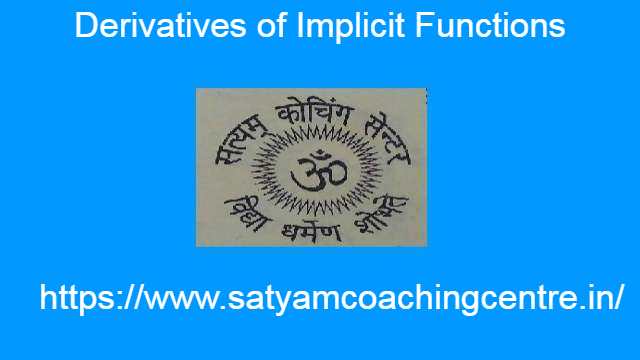Derivatives of Implicit Functions
1.असपष्ट फलनों के अवकलज (Derivatives of Implicit Functions),प्रतिलोम त्रिकोणमितीय फलनों के अवकलज (Derivatives of Inverse Trigonometric Functions):
असपष्ट फलनों के अवकलज (Derivatives of Implicit Functions) से पूर्व हम y=f(x) के रूप के विविध फलनों के अवकलन करते रहे हैं।परन्तु यह आवश्यक नहीं है कि फलनों का सदैव इसी रूप में व्यक्त किया जाए।उदाहरणार्थ x और y के बीच निम्नलिखित सम्बन्धों में से एक पर विशेष रूप से विचार कीजिए:
x-y-\pi=0, x+\sin x y-y=0
पहली दशा में हम y के लिए सरल कर सकते हैं और सम्बन्ध को y=x-\pi के रूप में लिख सकते हैं।दूसरी दशा में, ऐसा नहीं लगता है कि सम्बन्ध y को सरल करने का कोई आसान तरीका है।फिर भी दोनों में से किसी भी दशा में y की x पर निर्भरता के बारे में कोई सन्देह नहीं है।जब x और y के बीच का सम्बन्ध इस प्रकार व्यक्त किया गया हो कि उसे y के लिए सरल करना आसान हो और y=f(x) के रूप में लिखा जा सके तो हम कहते हैं कि y को x के स्पष्ट (explicit) फलन के रूप में व्यक्त किया गया है।उपर्युक्त दूसरे सम्बन्ध में हम कहते हैं कि y को x के अस्पष्ट (implicit) फलन के रूप में व्यक्त किया गया है।
आपको यह जानकारी रोचक व ज्ञानवर्धक लगे तो अपने मित्रों के साथ इस गणित के आर्टिकल को शेयर करें।यदि आप इस वेबसाइट पर पहली बार आए हैं तो वेबसाइट को फॉलो करें और ईमेल सब्सक्रिप्शन को भी फॉलो करें।जिससे नए आर्टिकल का नोटिफिकेशन आपको मिल सके । यदि आर्टिकल पसन्द आए तो अपने मित्रों के साथ शेयर और लाईक करें जिससे वे भी लाभ उठाए । आपकी कोई समस्या हो या कोई सुझाव देना चाहते हैं तो कमेंट करके बताएं।इस आर्टिकल को पूरा पढ़ें।
Also Read This Article:-Differentials of Composite Functions
2.असपष्ट फलनों के अवकलज के साधित उदाहरण (Derivatives of Implicit Functions Solved Examples):
निम्नलिखित प्रश्नों में \frac{dy}{dx} ज्ञात कीजिए:
Example:1.2 x+3 y=\sin x
Solution: 2 x+3 y=\sin x
x के सापेक्ष अवकलन करने पर:
2+3 \frac{d y}{d x}=\cos x \\ \Rightarrow \frac{3 d y}{d x}=\cos x-2 \\ \Rightarrow \frac{d y}{d x}=\frac{-2+\cos x}{3}
Example:2.2 x+3 y=\sin y
Solution:2 x+3 y=\sin y
x के सापेक्ष अवकलन करने पर:
2+3 \frac{d y}{d x}=\cos y \cdot \frac{d y}{d x} \\ \Rightarrow 3 \frac{d y}{d x}-\cos y \frac{d y}{d x}=-2 \\ \Rightarrow(3-\cos y) \frac{d y}{d x}=-2 \\ \Rightarrow \frac{d y}{d x}=\frac{-2}{3-\cos y} \\ \Rightarrow \frac{d y}{d x}=\frac{2}{-3+\cos y}
Example:3.a x+b y^{2}=\cos y
Solution:a x+b y^{2}=\cos y
x के सापेक्ष अवकलन करने पर:
a+2 b y\left(\frac{d y}{d x}\right)=-\sin y \left(\frac{d y}{d x}\right) \\ \Rightarrow 2 b y\left(\frac{d y}{d x}\right)+\sin y\left(\frac{d y}{d x}\right)=-a \\ \Rightarrow (2 b y+\sin y) \frac{d y}{d x}=-a \\ \Rightarrow \frac{d y}{d x}=\frac{-a}{2 b y+\sin y}
Example:4.x y+y^{2}=\tan x+y
Solution:x y+y^{2}=\tan x+y
x के सापेक्ष अवकलन करने पर:
y+x \frac{d y}{d x}+2 y \frac{d y}{d x}=\sec ^{2} x+\frac{d y}{d x} \\ x d y+2 y \frac{d y}{d x}-\frac{d y}{d x}=\sec ^{2} x-y \\ \Rightarrow(x+2 y-1) \frac{d y}{d x}=-y+\sec ^{2} x \\ \Rightarrow \frac{dy}{dx}=\frac{-y+\sec ^{2} x}{x+2 y-1}
Example:5.x^{2}+x y+y^{2}=100
Solution:x^{2}+x y+y^{2}=100
x के सापेक्ष अवकलन करने पर:
2 x+y+x \frac{d y}{d x}+2 y \left(\frac{d y}{d x}\right)=0 \\ \Rightarrow (x+2 y) \frac{d y}{d x}=-(2 x+y) \\ \Rightarrow \frac{d y}{d x}=-\frac{(2 x+y)}{x+2 y}
Example:6.x^{3}+x^{2} y+x y^{2}+y^{3}=81
Solution:x^{3}+x^{2} y+x y^{2}+y^{3}=81
x के सापेक्ष अवकलन करने पर:
Example:7.\sin ^{2} y+\cos x y=k
Solution:\sin ^{2} y+\cos x y=k
x के सापेक्ष अवकलन करने पर:
2 \sin y \cos y\left(\frac{d y}{d x}\right)-\sin x y\left(y+x \frac{d y}{d x}\right)=0 \\ \Rightarrow 2 \sin y \cos y \frac{d y}{d x}-y \sin x y-x \sin x y \frac{d y}{d x}=0 \\ \Rightarrow (2 \sin y \cos y-x \sin x y) \frac{d y}{d x}=y \sin y \\ \Rightarrow \frac{d y}{d x}=\frac{y \sin y}{(2 \sin y \cos y-x \sin x y)} \\ \Rightarrow \frac{d y}{d x}=\frac{y \sin y}{(\sin 2 y-x \sin x y)}
Example:8.\sin ^{2} x+\cos ^{2} y=1
Solution:\sin ^{2} x+\cos ^{2} y=1
x के सापेक्ष अवकलन करने पर:
2 \sin x \cos x-2 \cos y \sin y \frac{d y}{d x}=0 \\ 2 \cos y \sin y \frac{d y}{d x}=2 \sin x \cos x \\ \Rightarrow \frac{d y}{d x}=\frac{\sin 2 x}{\sin 2 y}
Example:9.y=\sin ^{-1}\left(\frac{2 x}{1+x^{2}}\right)
Solution:y=\sin ^{-1}\left(\frac{2 x}{1+x^{2}}\right)
put x=\tan \theta \Rightarrow \theta=\tan ^{-1} x \\ y =\sin ^{-1}\left(\frac{2 \tan \theta}{1+\tan ^{2} \theta}\right) \\ =\sin ^{-1}(\sin 2 \theta) \\ \Rightarrow y =2 \theta \\ \Rightarrow y=2 \tan ^{-1} x
x के सापेक्ष अवकलन करने पर:
\frac{d y}{d x}=\frac{2}{1+x^{2}}
Example:10.y=\tan ^{-1}\left(\frac{3 x-x^{3}}{1-3 x^{2}}\right),-\frac{1}{\sqrt{3}}<x<\frac{1}{\sqrt{3}}
Solution:y=\tan ^{-1}\left(\frac{3 x-x^{3}}{1-3 x^{2}}\right)
put x=\tan \theta \Rightarrow \theta=\tan ^{-1} x \\ y=\tan ^{-1}\left(\frac{3 \tan \theta-\tan ^{2} \theta}{1-3 \tan ^{2} \theta}\right) \\ =\tan ^{-1}(\tan 3 \theta) \\ \Rightarrow y=3 \theta \\ \Rightarrow y=3 \tan ^{-1} x
x के सापेक्ष अवकलन करने पर:
\frac{d y}{d x}=\frac{3}{1+x^{2}}
Example:11. y=\cos ^{-1}\left(\frac{1-x^{2}}{1+x^{2}}\right),0<x<1
Solution: y=\cos ^{-1}\left(\frac{1-x^{2}}{1+x^{2}}\right)
Put x=\tan \theta \Rightarrow \theta=\tan ^{-1} x \\ y=\cos ^{-1}\left(\frac{1-\tan ^{2} \theta}{1+\tan ^{2} \theta}\right) \\ \Rightarrow y=\cos^{-1}(\cos 2 \theta) \\ \Rightarrow y=2 \theta \\ \Rightarrow y=2 \tan^{-1} x
x के सापेक्ष अवकलन करने पर:
\Rightarrow \frac{d y}{d x}=\frac{2}{1+x^{2}}
Example:12. y=\sin ^{-1}\left(\frac{1-x^{2}}{1+x^{2}}\right), 0<x<1
Solution: y=\sin ^{-1}\left(\frac{1-x^{2}}{1+x^{2}}\right)
Put x=\tan \theta \Rightarrow \theta=\tan ^{-1} x \\ y=\sin ^{-1}\left(\frac{1-\tan ^{2} \theta}{1+\tan ^{2} \theta}\right) \\ \Rightarrow y=\sin ^{-1}(\cos 2 \theta) \\ \Rightarrow y=\sin ^{-1}\left[\sin \left(\frac{\pi}{2}-2 \theta\right)\right] \\ \Rightarrow y=\frac{\pi}{2}-2 \theta \\ \Rightarrow y=\frac{\pi}{2}-2 \tan ^{-1} x
x के सापेक्ष अवकलन करने पर:
\frac{d y}{d x}=-\frac{2}{1+x^{2}}
Example:13. y=\cos ^{-1}\left(\frac{2 x}{1+x^{2}}\right),-1<x<1
Solution: y=\cos ^{-1}\left(\frac{2 x}{1+x^{2}}\right)
Put x=\tan \theta \Rightarrow \theta=\tan ^{-1} x \\ y=\cos ^{-1}\left(\frac{2 \tan \theta}{1+\tan \theta}\right) \\ \Rightarrow y=\cos^{-1} (\sin 2 \theta) \\ \Rightarrow y=\cos^{-1} \left[\cos \left(\frac{\pi}{2}-2 \theta\right)\right] \\ \Rightarrow y=\frac{\pi}{2}-2 \theta \\ \Rightarrow y=\frac{\pi}{2}-2 \tan^{-1} x
x के सापेक्ष अवकलन करने पर:
\frac{d y}{d x}=-\frac{2}{1+x^{2}}
Example:14.y=\sin ^{-1}\left(2 x \sqrt{1-x^{2}}\right),-\frac{1}{\sqrt{2}}<x<\frac{1}{\sqrt{2}}
Solution: y=\sin ^{-1}\left(2 x \sqrt{1-x^{2}}\right)
Put x =\sin \theta \Rightarrow \theta=\sin ^{-1} x \\ y= \sin ^{-1}\left(2 \sin \theta \sqrt{1-\sin ^{2} \theta}\right)\\ = \sin ^{-1}\left(2 \sin \theta \sqrt{\cos ^{2} \theta}\right) \\ = \sin^{-1} (2 \sin \theta \cos \theta) \\ = \sin^{-1} (\sin 2 \theta) \\ \Rightarrow y=2 \theta \\ \Rightarrow y=2 \sin ^{-1} x
x के सापेक्ष अवकलन करने पर:
\frac{d y}{d x}=\frac{2}{\sqrt{1-x^{2}}}
Example:15. y=\sec ^{-1}\left(\frac{1}{2 x^{2}-1}\right), 0<x<\frac{1}{\sqrt{2}}
Solution: y=\sec ^{-1}\left(\frac{1}{2 x^{2}-1}\right)
Put x =\cos \theta \Rightarrow \theta=\cos ^{-1} x \\ y =\sec ^{-1}\left(\frac{1}{2 \cos ^{2} \theta-1}\right) \\ =\sec ^{-1}\left(\frac{1}{\cos 2 \theta}\right) \\ =\sec ^{-1}\left(\sec 2 \theta\right) \\ \Rightarrow y =2 \theta \\ \Rightarrow y =2 \cos ^{-1} x
x के सापेक्ष अवकलन करने पर:
\frac{d y}{d x}=-\frac{2}{\sqrt{1-x^{2}}}
उपर्युक्त उदाहरणों के द्वारा असपष्ट फलनों के अवकलज (Derivatives of Implicit Functions),प्रतिलोम त्रिकोणमितीय फलनों के अवकलज (Derivatives of Inverse Trigonometric Functions) को समझ सकते हैं।
3.असपष्ट फलनों के अवकलज के सवाल (Derivatives of Implicit Functions Questions):
निम्नलिखित फलनों से \frac{dy}{dx} ज्ञात कीजिए:
(1.) \tan (x+y)+\tan (x-y)=4 \\ (2.) x \sqrt{y}+y \sqrt{x}=1 \\ (3.) x^{a} \cdot y^{b}=(x-y)^{a+b} \\ (4.) \sqrt{e^{\sqrt{x}}}
उत्तर (Answers):\text { (1.) } \frac{d y}{d x}=\frac{\sec ^{2}(x+y)+\sec ^{2}(x-y)}{\sec^{2}(x-y)-\sec ^{2}(x+y)} \\ \text { (2.) } \frac{d y}{dx}=-\frac{y}{x}\left[\frac{\sqrt{y}+2 \sqrt{x}}{\sqrt{x}+2 \sqrt{y}}\right] \\ \text { (3.) } \frac{d y}{d x}=\frac{y}{x} \\ \text { (4.) }\frac{e^{\sqrt{x}}}{4 \sqrt{x e^{\sqrt{x}}}}
उपर्युक्त सवालों को हल करने पर असपष्ट फलनों के अवकलज (Derivatives of Implicit Functions),प्रतिलोम त्रिकोणमितीय फलनों के अवकलज (Derivatives of Inverse Trigonometric Functions) को ठीक से समझ सकते हैं।
Also Read This Article:-Integration by Substitution Class 12
4.असपष्ट फलनों के अवकलज (Derivatives of Implicit Functions),प्रतिलोम त्रिकोणमितीय फलनों के अवकलज (Derivatives of Inverse Trigonometric Functions) के सम्बन्ध में अक्सर पूछे जाने वाले प्रश्न:
प्रश्न:1.अस्पष्ट फलनों के अवकलज से क्या तात्पर्य है? (What is meant by Derivatives of Implicit Functions?):
उत्तर:अस्पष्ट फलन (Implicit Function): यदि किसी समीकरण में x तथा y दोनों चर हों तथा इसमें y को x के फलन के रूप (या x को y के फलन के रूप) में स्पष्ट रूप में व्यक्त नहीं किया जा सके तो ऐसे फलनों को अस्पष्ट फलन कहते हैं।
इनका अवकलन ज्ञात करने के लिए y को x का फलन मानकर समीकरण f(x,y)=0 के प्रत्येक पद का x के सापेक्ष अवकलन करके \frac{dy}{dx} का मान ज्ञात कर सकते हैं।
प्रश्न:2.स्पष्ट फलनों के अवकलज से क्या तात्पर्य है? (What is meant by Derivatives of Explicit Functions?):
उत्तर:स्पष्ट फलन (Explicit Function):यदि किसी समीकरण में x तथा y दोनों चर हों तथा इसमें y को x के (या x को y के) फलन के रूप में व्यक्त किया जा सके तो y को x का (या x को y का) स्पष्ट फलन कहते हैं।इस प्रकार फलनों को y=f(x) या x=f(y) के रूप में रखकर \frac{dy}{dx} या \frac{dx}{dy} का मान ज्ञात कर सकते हैं।
प्रश्न:3.प्रतिलोम त्रिकोणमितीय फलनों के मानक अवकलज लिखो।(Write the Standard Derivatives of Inverse Trigonometric Functions):
उत्तर:कुछ मानक अवकलज (परिभाषित प्रान्तों में) निम्नलिखित हैं:
(1.) \frac{d}{d x}\left(\sin ^{-1} x\right)=\frac{1}{\sqrt{1-x^{2}}} \\ (2.) \frac{d}{d x}(\cos^{-1} x)=-\frac{1}{\sqrt{1-x^{2}}} \\ (3.) \frac{d}{d x}\left(\tan ^{-1} x\right)=\frac{1}{1+x^{2}} \\ (4) \frac{d}{d x}\left(\cot ^{-1} x\right)=-\frac{1}{1+x^{2}} \\ (5.)\frac{d}{d x}\left(\sec ^{-1} x\right)=\frac{1}{|x| \sqrt{x^{2}-1}} \\ (6.) \frac{d}{d x}\left(\operatorname{cosec}^{-1} x\right)=\frac{-1}{|x| \sqrt{x^{2}-1}} \\ (7) \frac{d}{d x}\left(e^{x}\right)=e^{x} \\ (8) \frac{d}{d x}(\log x)=\frac{1}{x}
उपर्युक्त प्रश्नों के उत्तर द्वारा असपष्ट फलनों के अवकलज (Derivatives of Implicit Functions), प्रतिलोम त्रिकोणमितीय फलनों के अवकलज (Derivatives of Inverse Trigonometric Functions) के बारे में ओर अधिक जानकारी प्राप्त कर सकते हैं।
| No. | Social Media | Url |
|---|---|---|
| 1. | click here | |
| 2. | you tube | click here |
| 3. | click here | |
| 4. | click here | |
| 5. | Facebook Page | click here |
| 6. | click here |
Derivatives of Implicit Functions
असपष्ट फलनों के अवकलज
(Derivatives of Implicit Functions)
Derivatives of Implicit Functions
असपष्ट फलनों के अवकलज (Derivatives of Implicit Functions) से पूर्व हम y=f(x) के
रूप के विविध फलनों के अवकलन करते रहे हैं।परन्तु यह आवश्यक नहीं है कि फलनों का
सदैव इसी रूप में व्यक्त किया जाए।







